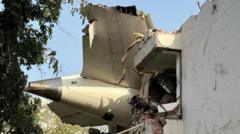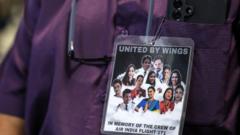Following a catastrophic accident that claimed at least 270 lives, Air India is battling significant challenges as it seeks to recover from the deepening crisis just as it was beginning to improve its image and operations.
Air India Faces Turmoil After Devastating Crash Threatens Recovery Plans

Air India Faces Turmoil After Devastating Crash Threatens Recovery Plans
The tragic crash of Air India flight AI-171 has cast a long shadow over the airline's ambitious turnaround strategy.
In the aftermath of the Air India-171 crash, international investigators are collaborating to determine the root cause of the tragedy. Meanwhile, the Tata Group, which acquired the airline in 2022, finds itself facing obstacles that threaten its efforts to reinvigorate the carrier.
Before the crash, Air India had shown signs of positive change. The airline recorded an operating profit, improved customer feedback, and underwent a significant transformation with new aircraft and enhanced services. Aiming to establish itself as a "world-class" airline, Air India was in the midst of a turnaround that appeared to be gaining momentum.
However, the recent crash has instigated fear and a temporary backlash among passengers, with many declaring they will no longer fly with Air India. Although the Dreamliner aircraft had an overall commendable safety record, the scale of this incident has understandably shaken public confidence. Experts, such as Jitendra Bhargava, a former Air India executive director, predict that the disaster will likely deter travelers in the short term, leading to a noticeable drop in bookings.
In addition to the crash, Air India has faced other operational challenges, including technical issues with aircraft engines and a bomb threat on a flight, compounding concerns about safety standards and reliability. Analysts anticipate that the airline’s turnaround will require additional time and resources to address these multifaceted issues.
In reaction to the crash, Air India has already begun reducing international services to enhance safety inspections, showcasing the imbalance that this tragedy has created for the airline’s operations. As regulatory bodies from the UK, US, and India scrutinize Air India's safety protocols, questions will need to be answered about the maintenance of its aging fleet and how the airline intends to pursue necessary reforms.
Air India's CEO and Tata Group leadership have emphasized their commitment to supporting victims' families and cooperating fully with the investigation. They acknowledge the need for transparent communication to rebuild trust with customers. Recognizing the importance of strong engagement during crises, they hope to utilize this distressing period as an opportunity to reinforce their commitment to enhanced safety measures.
Nevertheless, the road to recovery appears extensive. It is crucial for Air India not only to address immediate operational challenges but also rebuild its brand image. Partnering with Singapore Airlines—a globally recognized carrier—may offer some strategic advantages in navigating through this turmoil.
Looking ahead, it is essential that the airline takes these circumstances as a catalyst for significant change while balancing the pressures of restoring its reputation.
As Air India confronts this tumultuous chapter, the airline must work diligently to regain public trust and secure its place in India's thriving aviation market, all while dealing with the devastating consequences of the recent crash.
Before the crash, Air India had shown signs of positive change. The airline recorded an operating profit, improved customer feedback, and underwent a significant transformation with new aircraft and enhanced services. Aiming to establish itself as a "world-class" airline, Air India was in the midst of a turnaround that appeared to be gaining momentum.
However, the recent crash has instigated fear and a temporary backlash among passengers, with many declaring they will no longer fly with Air India. Although the Dreamliner aircraft had an overall commendable safety record, the scale of this incident has understandably shaken public confidence. Experts, such as Jitendra Bhargava, a former Air India executive director, predict that the disaster will likely deter travelers in the short term, leading to a noticeable drop in bookings.
In addition to the crash, Air India has faced other operational challenges, including technical issues with aircraft engines and a bomb threat on a flight, compounding concerns about safety standards and reliability. Analysts anticipate that the airline’s turnaround will require additional time and resources to address these multifaceted issues.
In reaction to the crash, Air India has already begun reducing international services to enhance safety inspections, showcasing the imbalance that this tragedy has created for the airline’s operations. As regulatory bodies from the UK, US, and India scrutinize Air India's safety protocols, questions will need to be answered about the maintenance of its aging fleet and how the airline intends to pursue necessary reforms.
Air India's CEO and Tata Group leadership have emphasized their commitment to supporting victims' families and cooperating fully with the investigation. They acknowledge the need for transparent communication to rebuild trust with customers. Recognizing the importance of strong engagement during crises, they hope to utilize this distressing period as an opportunity to reinforce their commitment to enhanced safety measures.
Nevertheless, the road to recovery appears extensive. It is crucial for Air India not only to address immediate operational challenges but also rebuild its brand image. Partnering with Singapore Airlines—a globally recognized carrier—may offer some strategic advantages in navigating through this turmoil.
Looking ahead, it is essential that the airline takes these circumstances as a catalyst for significant change while balancing the pressures of restoring its reputation.
As Air India confronts this tumultuous chapter, the airline must work diligently to regain public trust and secure its place in India's thriving aviation market, all while dealing with the devastating consequences of the recent crash.





















